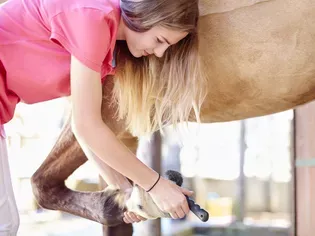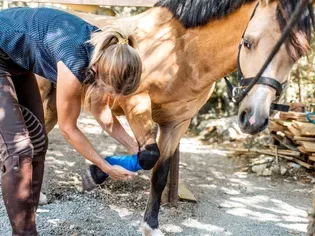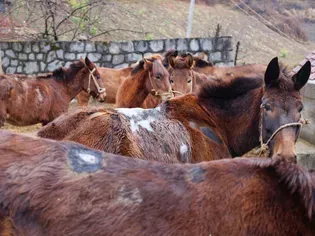Papillomas in Horses
Updated on 04/26/24

Unveiling the Enigmatic Papillomas: A Comprehensive Guide for Horse Owners
Papillomas, enigmatic equine growths, have perplexed horse owners and veterinarians alike for centuries. Characterized by their distinctive cauliflower-like appearance, these benign tumors pose a range of concerns, from mild cosmetic blemishes to potential health complications. In this comprehensive guide, we delve into the captivating world of papillomas in horses, exploring their causes, symptoms, treatment options, and preventative measures.
The Tapestry of Papillomas: A Multifaceted Etiology
The genesis of papillomas lies in the equine papillomavirus (EPV), a highly contagious pathogen that gains entry into the horse's immune system through microscopic abrasions on the skin. Once inside, the virus hijacks healthy cells, using their cellular machinery to create more copies of itself. This viral replication stimulates the growth of papillomas, which are essentially skin tumors composed of excessive keratin, the protein that forms hair and nails.
Unmasking the Symptoms: A Telltale Silhouette
Papillomas manifest in a kaleidoscope of sizes, shapes, and textures, ranging from small, warty bumps to large, cauliflower-like protrusions. They typically arise on areas of the horse's body that are prone to friction or abrasion, such as the face, legs, and genitals. While most papillomas are benign and pose no health risks, large or numerous growths can obstruct movement, impair vision, or lead to secondary infections.
Navigating Treatment Options: From Surgical Precision to Holistic Harmony
The treatment approach for papillomas in horses depends on the severity of the condition and the individual horse's needs. The following options provide a broad spectrum of intervention strategies:
* Surgical Excision: This invasive procedure involves the physical removal of the papillomas using a scalpel or laser. While effective in eradicating the growths, it can leave scars and does not prevent future recurrence.
* Cryotherapy: This technique employs liquid nitrogen to freeze and destroy the papillomas. While less invasive than surgery, it requires multiple treatments and may not be suitable for large or numerous growths.
* Immunotherapy: This innovative treatment harnesses the horse's immune system to fight off the papillomavirus. It involves administering vaccines or other immune-boosting agents to stimulate the horse's natural defenses.
* Holistic Approaches: Some holistic practitioners advocate for using natural remedies such as thuja occidentalis, a plant extract believed to have antiviral properties, or aloe vera, which possesses anti-inflammatory and antibacterial properties.
Prevention: A Proactive Shield against Papillomas
Preventing papillomavirus infection and subsequent papilloma formation is the cornerstone of responsible horse ownership. The following measures can significantly reduce the risk of equine papillomas:
* Vaccination: Vaccination is the most effective way to protect horses from the equine papillomavirus. Multiple vaccines are available, providing immunity for varying durations.
* Quarantine: Isolate horses that exhibit papillomas to prevent the spread of the virus to other horses in the herd.
* Disinfection: Thoroughly disinfect areas where horses have been exposed to papilloma-infected individuals or their excretions.
* Hygiene Maintenance: Maintain a clean and sanitary environment for your horses, minimizing the risk of viral exposure through contaminated surfaces or contact with infected animals.
Conclusion: A Journey of Understanding and Empowerment
Papillomas in horses, while often benign, can cause discomfort, impair function, and compromise overall well-being. Understanding the causes, symptoms, and treatment options for papillomas empowers horse owners with the knowledge to make informed decisions about their animals' health. By employing proactive prevention strategies, we can safeguard our equine companions against this enigmatic viral infection. Remember, the journey of caring for horses is one of continuous learning, empathy, and unwavering dedication to their well-being.
Explore More Pets

Pony Breeds
The Difference Between Horses and Ponies

Horse Diseases & Conditions
What Do I Do If My Horse Colics?

Pony Breeds
Horse and Pony Care by the Day, Week, Month and Year

Horse Grooming
Mange in Horses

Horse Diseases & Conditions
Grease Heel in Horses

Light Horse Breeds
Gypsy Vanner Horse Breed Profile

Horse Diseases & Conditions
Girth Galls and Saddle Sores

Pony Breeds
Shetland Pony Breed Profile